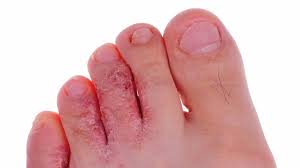El pie de atleta o tinea pedis es una infección fúngica de la piel que afecta principalmente a los pies. Recibe su nombre del hecho de que los atletas a menudo lo obtienen. Mitch Hedberg dijo una vez: “No me gustan los deportes. Si alguien alguna vez me dijo que tenía pie de atleta, diría que ese no es mi pie “, pero triste para él, ¡porque esta condición de picazón le puede pasar a cualquiera! El pie de atleta ocurre con mucha frecuencia en personas cuyos pies se han vuelto muy sudorosos mientras se encuentran dentro de zapatos ajustados durante largos intervalos de tiempo.
Contenido
¿Qué causa el pie de atleta?
Causas
Hay 2 tipos de hongos que pueden causar la condición.
- Trichophyton mentagrophytes causa infecciones de la pared del pie o vesiculares (ampollas). La infección aparece de repente, es grave y se trata fácilmente.
- El segundo tipo de hongos se llama Trichophyton rubrum y causa una infección de tipo mocasín. Esta condición dura mucho tiempo (crónica) y es difícil de tratar.
Hay dos cosas que un hongo necesita para crecer y prosperar: la humedad y el calor. Los pies sudorosos envueltos en zapatos sofocantes ofrecen una gran cantidad de ambos.
Transmisión
La gente más comúnmente recoge los hongos de las superficies húmedas y contaminadas, como los pisos de las duchas públicas o los vestuarios. Es muy contagioso y puede contagiarse no solo al tocar la región afectada de una persona infectada, sino también al usar las toallas o el jabón de la persona. La infección puede propagarse de un pie al otro y también a las manos (entre los dedos), especialmente si se rasca o pica las partes infectadas.
Factores de riesgo
Ahora que sabemos qué causa el pie de atleta, los factores de riesgo son obvios.
- Los zapatos gruesos y apretados que aprietan los dedos juntos proporcionan las condiciones ideales para que el hongo prospere.
- Los zapatos de plástico, que calientan y humedecen más los pies, son más propensos a poner el pie de atleta más rápido que los hechos de otros materiales como el cuero o el lienzo.
- Poor hygiene, including not washing feet properly and regularly or wearing dirty socks.
- Leaving the feet moist after being in contact with water or keeping feet wet for long periods of time.
- Having a history of being susceptible to fungal infections.
- Aging. Athlete’s foot is more common in older adults. Children seldom get it.
- Share mats, rugs, bed linens, clothes, towels or shoes with someone who has a fungal infection.
- Walk barefoot in public areas where the infection can spread, such as locker rooms, saunas, swimming pools, communal baths and showers.
- Having a weakened immune system
- Being male
What Are the Symptoms of Athlete’s Foot?
Athlete’s foot is fairly easy to identify. The symptoms include itchy, scaly, red rash that develops between the toes. The itching is the worst when you just remove your shoes and socks.
- The toe web type of infection makes the skin pale and moist. Itching, burning and a mild odour are obvious. As the infection worsens the skin becomes scaly and can crack and peel off.
- The vesicular type causes blisters that can burst and ooze fluids. The blisters most often develop on the skin of the instep but may also develop between the toes, at the heel, on the sole or at the top of the foot. The moccasin variety of athlete’s feet causes chronic dryness and scaling on the soles that extends all the way along the sides of the feet. It can be mistaken for eczema or even as dry skin.
How to Deal With Athlete’s Foot
Athlete’s foot might seem squeamishly scary, but is very much treatable. There are self-care things that can do, get OTC medicines, or consult a doctor. Upon realising what causes athlete’s foot, the best thing you could do is take measures to avoid and treat it.
Self-Care
- Keep your feet clean and dry: Wear clean, absorbent socks made of natural fibers such as cotton, and change them during the day if your feet become moist or sweaty. Always opt for shoes that are breezy and avoid plastic ones.
- Remove the insoles of shoes and sneakers, if possible, to allow them to dry out overnight. Dusting the inside of your shoes and socks with talcum powder or a medicated powder such as Desenex will help to decrease the moisture level.
- Alternate between different pairs of shoes to allow them to dry out for a day or two at a time.
Medical Treatment
- Over-the-counter antifungal creams are sufficient for treating most cases of athlete’s foot. Apply them as directed to the toes and foot. Common brands include clotrimazole (Lotrimin) and tolnaftate (Tinactin).These creams should be used sparingly but regularly, at least once a day.
- An oral antifungal medication will be prescribed if the topical antifungal medications do not clear up the infection.
- If you plan to see your physician for a diagnosis or treatment of your athlete’s foot, it would be advisable to stop using any antifungal medication for at least two weeks as it could inhibit an accurate diagnosis.
- Si planea visitar a un médico el próximo mes, la aplicación de crema de hidrocortisona al 1%adquirida sin receta sería una táctica terapéutica ideal. Dado que muchas de las causas del pie de atleta no son infecciones y pueden responder a este medicamento. Además, mejorará la capacidad de su médico para encontrar organismos fúngicos en caso de que sean la causa.

